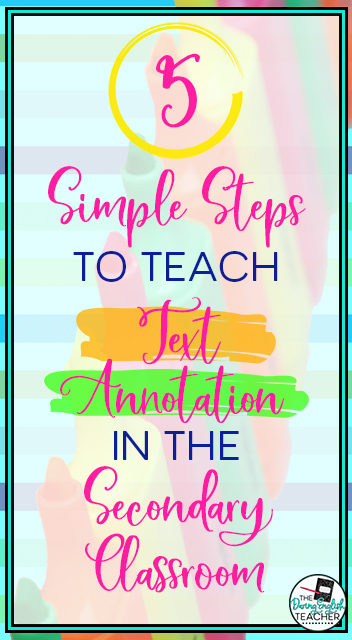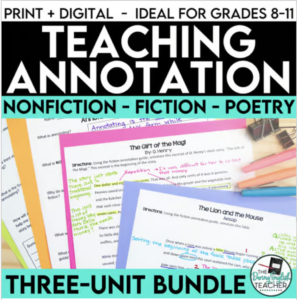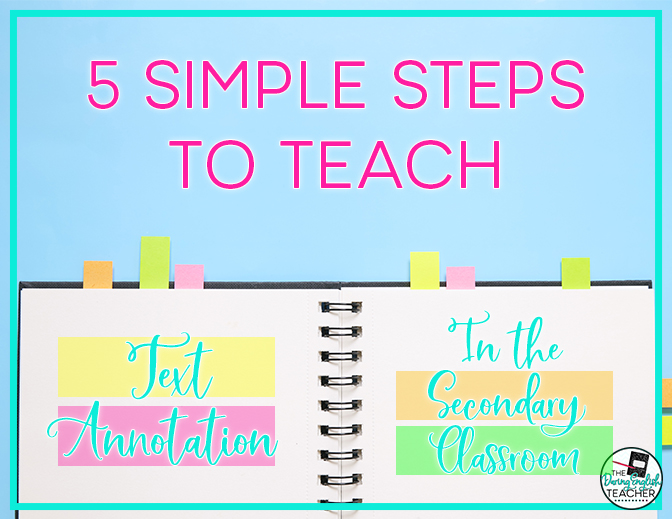Teaching students how to annotate text can be an intimidating task. Likewise, for our students, annotating text can be equally as daunting, especially if they don’t have a process of their own that works or steps to follow. However, teaching text annotation can be a simple and straightforward task if you follow these five steps.
When I teach my students how to annotate text, I use these simple steps to break down the process into a manageable task for my students. There are also a variety of strategies that I use when I teach and model students how to annotate text.
Teaching Text Annotation Step 1: Preview the Text
Before I have my students annotate text, I want them to get an overall feel for the text. I have them look at and read headlines, subheads, pictures, captions, headings, graphs, and pull-out quotes. It is also helpful to have a classroom discussion to activate prior knowledge about the topic of the text.
Teaching Text Annotation Step 2: Read a Small Section of Text 
Since close reading and text annotation can be a daunting task, I have my students only focus on a small portion of it at a time. This makes the task less intimidating for students. It also enables them to focus more closely on a section of text rather than get lost in the entirety of the text. When we first begin annotating at the start of a new school year, we typically just focus on one paragraph at a time. By doing so, this helps build student confidence.
Teaching Text Annotation Step 3: Annotate the Section You Read
Once they’ve read the small section, I provide my students with (or encourage them to) go back and annotate the section they’ve just read. As they become more confident in their close reading and text annotation skills, students will incorporate steps 2 and 3 together, but as they are learning and practicing the skill, I’ve found that students annotate more thoroughly when they read and then annotate.
Teaching Text Annotation Step 4: Review Your Annotations
It is essential to have students go back and review their annotations. This reinforces the process that the students are completing, as well as gives them an opportunity to review their annotations and margin notes so that they gain a better understanding of the text. One way that I like to review annotations in class is to have students partner up after completing individual annotations. In partner groups, they share their notes with one another. This is especially helpful if you have students partner up two different times. They will get to see annotations from two other students.
Teaching Text Annotation Step 5: Repeat Steps 2-4
As students work through the text, they will complete steps 2-4 until they finish annotating the entire document. As students near the end of the document, they will become more confident in their annotating abilities.
While annotating all different types of text generally follows these steps, there are a few different things that I do when I teach my students how to annotate fiction, annotate nonfiction, and annotate poetry. I’ve included all of these lessons and resources in an Annotating Made Simple Bundle.
Annotating Text Made Easy Teaching Resource 
Annotating Text, Annotating Fiction, Annotating Poetry: Teach your students how to efficiently annotate any kid of text with these step-by-step, guided, text annotation lessons and class exercises! Now includes print and digital options!
Begin your unit with a presentation for direct instruction. Students will use the included guided notes to follow along with the lesson. Then, work together in a whole-class setting to annotate a piece of text together using guided instructions and step-by-step pacing.
What Teachers Say:
⭐️⭐️⭐️⭐️⭐️ Extremely satisfied
“This really helped my students who were struggling with the concept of annotation. Following the suggested annotation styles for the different types of text (fictional, informational, and poetry) made it easier for me to review their annotations and determine where a student may need some extra help. I really liked this bundle.”
⭐️⭐️⭐️⭐️⭐️ Extremely satisfied
“This annotating toolkit is a 5-star win for teaching your students how to mark up texts, fiction, or poetry. With cool step-by-step lessons and both print and digital options, setting up an engaging class is a breeze. Want to make annotating fun and easy? This is your go-to resource!”
⭐️⭐️⭐️⭐️⭐️ Extremely satisfied
“This was a great resource to help students understand how to properly annotate. I appreciated the bundle for students to compare different texts. I did find the power points to be very similar though.”


